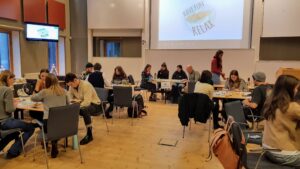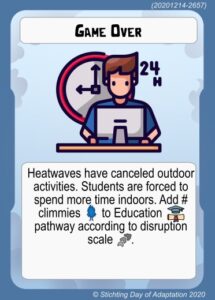Just over two months ago, the Intergovernmental Panel on Climate Change (IPCC) released its sixth assessment report, which looked into the impacts of climate change on ecosystems, biodiversity and human communities at global and regional level. The main messages highlighted the lack of sufficient action to date and the UN Secretary-General Antonio Guterres even called the report “An atlas … of failed climate leadership.“
As the growing evidence on climate change impacts becomes harder to face, engagement with the topic also becomes more difficult. Topics can be considered abstract or intangible by some, while for others, they seem distant from day-to-day experiences. It is in this sphere that Day of Adaptation operates. In our last blogs , we looked into gamification as a new approach towards resilience, adaptive capacity and climate action. We also delved deeper into how game elements can trigger (unexpected) emotions within us. In this post, we explore available insights to communicate climate change action and make it more relatable to individuals, communities and organisations.
The academic literature on climate change communication makes it clear that there is not one manner in which the message can be shared with an audience, instead the goal should always remain to connect with your audience on the basis of trust, and share values and open discussions. Likewise, the IPCC also released a handbook on “Principles for effective communication on public engagement on climate”, which provides top tips for communicators trying to use climate science to encourage public engagement and awareness activities.
DAYAD provides its own twist to the concepts and focuses on meeting participants in the place of engagement, whether that is in a classroom, office or at home. Through our boardgame ‘Minions of Disruptions’, participants are able to become more comfortable with us and other participants, converse freely while playing the game and reflecting openly on their experience.
In this regard, the ability of the game to encourage discussion and provide practical examples about the real world (e.g. heatwaves making it difficult to do groceries) instead of more abstract ( e.g. impact of heatwaves) creates a common ground and relatability with an often difficult to imagine topic. It also helps to set the stage for the post game reflection, in which participants can build on local points of interest to connect with facts, figures and statistics abundantly present in climate change science.

Game Day participants in the midst of a game session.
Minions of Disruptions distils the complexity of climate change into a more straight-forward narrative with clear superheroes (Zillians) and villains (Climmies). In real-life, the impacts of climate change are much more nuanced and can impact communities in complex interconnected ways. The challenge is in finding the balance between a compelling narrative based the latest understanding of the uncertainties inherent in scientific climate discussions and representing the information in more relatable, simplified manners, as we see with the aforementioned superheroes and villains.
Our participants have indicated in post-game surveys that adding the characters to the board game assists by increasing the fun and reducing the barrier to playing a game inherently grounded in such complexities. In the same way, the visual language of our board game plays an important role in reframing climate change from melting ice-caps and environmental protestors to more diverse, local-level imagery. The combination of initiative and disruption cards can create new visual identifiers and help people reflect on the issue through new stories and emotions.

Disruption card from the Minions of Disruptions game showing the impacts of climate change on education.
Our experience teaches us that this not only increases familiarity with the cross-sectoral issues of the topic, but also creates a critical entry point into heavier topics. Facilitating the board game and hosting the discussion afterward is enriching not only for the participants unfamiliar with the issues, but also for seasoned facilitators who are constantly learning about social and personal concerns regarding climate change.
We have seen time and time again that sharing thoughts on this all important topic after having played a session, takes us out of the familiar discussion paths and makes it possible to consider new avenues for discussions. In our conversations with university students, there was a clear focus on smaller scale initiatives students can take to address their own impact (e.g recycling clothes, bringing water bottles from home and leading local initiatives), while discussions with other NGOs certain much more on the organisational impacts of climate change and how teams can collectively improve their actions (e.g. car pooling, less food waste and turning down ACs).
It is these elements that inspire us to continue working on this subject matter. To progress, climate action needs not only science but also relatable, emotional and understandable communication. We look forward to having more conversations on in the future!
Author: Rishi Kumar
